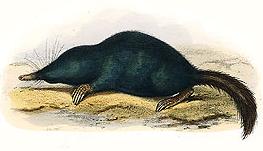
Moles are small mammals adapted to a subterranean lifestyle. They have cylindrical bodies, velvety fur, very small, inconspicuous eyes and ears, reduced hindlimbs, and short, powerful forelimbs with large paws adapted for digging.

The order Insectivora is a now-abandoned biological grouping within the class of mammals. Some species have now been moved out, leaving the remaining ones in the order Eulipotyphla within the larger clade Laurasiatheria, which makes up one of the basal clades of placental mammals.

Eulipotyphla is an order of mammals suggested by molecular methods of phylogenetic reconstruction, which includes the laurasiatherian members of the now-invalid polyphyletic order Lipotyphla, but not the afrotherian members.

The family Talpidae includes the moles who are small insectivorous mammals of the order Eulipotyphla. Talpids are all digging animals to various degrees: moles are completely subterranean animals; shrew moles and shrew-like moles somewhat less so; and desmans, while basically aquatic, excavate dry sleeping chambers; whilst the quite unique star-nosed mole is equally adept in the water and underground. Talpids are found across the Northern Hemisphere of Eurasia and North America, and range as far south as the montane regions of tropical Southeast Asia.

The desman, a snouted and naked-tailed diving insectivore of the tribe Desmanini, belongs to one of two Eurasian species of the mole family, Talpidae.

The shrew moles or shrew-like moles (Uropsilus) are shrew-like members of the mole family of mammals endemic to the forested, high-alpine region bordering China, Myanmar, and Vietnam. They possess a long snout, a long slender tail, external ears, and small forefeet unspecialized for burrowing. Although they are similar to shrews in size, external appearance, and, presumably, ecological habits, they are nevertheless talpids and considered true moles, as they share a full zygomatic arch with all other moles, while this arch is completely absent in shrews.

Neurotrichus is a genus of shrew-like moles. It is classified, together with the fossil genus Quyania, in the tribe Neurotrichini of the subfamily Talpinae. The only living species is the American shrew-mole (N. gibbsii) of the northwestern United States and British Columbia. A fossil species, Neurotrichus columbianus from the Hemphillian of Oregon, was placed in the genus in 1968, but this animal is now thought to be more closely related to the Chinese fossil genus Yanshuella.
A shrew mole or shrew-mole is a mole that resembles a shrew. Species with this name include:

The Pyrenean desman or Iberian desman is a small semiaquatic, globally threatened mammal related to moles and shrews, and, along with the Russian desman , is one of the two extant members of the tribe Desmanini. The species occurs in north and central parts of Spain and Portugal, French Pyrenees, and Andorra, but severe range contractions have been documented across its geographic distribution.

Soricomorpha is a formerly used taxon within the class of mammals. In the past it formed a significant group within the former order Insectivora. However, Insectivora was shown to be polyphyletic and various new orders were split off from it, including Afrosoricida, Macroscelidea, and Erinaceomorpha, with the four remaining extant and recent families of Soricomorpha shown here then being treated as a separate order. Insectivora was left empty and disbanded.

Neurotrichini is a tribe within the subfamily Talpinae of the mole family. It includes the living genus Neurotrichus with a single living species, the American shrew-mole. While today restricted to the New World, fossils are known from Eurasia.

True's shrew mole is a species of mammal in the family Talpidae. It is endemic to Japan and is a common species above 1000 meters in grassland, shrubland and forest. Sometimes this species is called the lesser Japanese shrew mole and another species, Urotrichus talpoides, is called the "greater Japanese shrew mole".

The Japanese shrew mole or himizu (ヒミズ) is a species of mammal in the family Talpidae. It is endemic to Japan and is found on Honshu, Shikoku, Kyushu, Awaji Island, Shodo Island, Oki Islands, Tsushima Island, Goto Islands, Mishima Island, and Awashima Island, but is absent from Hokkaido, which is north of Blakiston's Line. It is one of three Urotrichini and it is the only extant species in the genus Urotrichus. It is common between sea level and approximately 2,000 m. Sometimes this species is called the greater Japanese shrew mole and another species, True's shrew mole, is called the "lesser Japanese shrew mole".

Talpini is a tribe of mammals known as Old World Moles. It is a division of the subfamily Talpinae.

Urotrichini is a tribe of the mole family, and consists of Japanese and American shrew-moles. They belong to the Old World moles and relatives branch of the mole family (Talpidae). There are only two species, each of which represents its own genus. The name "shrew-moles" refers to their morphological resemblance to shrews, while generally being thought of as "true moles". The species are the Japanese shrew mole, True's shrew mole and American shrew mole.

The Scalopinae, or New World moles, are one of three subfamilies of the family Talpidae, which consists of moles and mole-like animals; the other two subfamilies being the Old World talpids and the Chinese shrew-like moles (Uropsilinae). The Scalopinae are the only Talpidae subfamily to consist entirely of undisputed moles and no mole-like close relatives such as shrew-moles or desmans.

Ognev's mole is a species of mammal in the family Talpidae. It occurs in the southeastern coastal area of the Black Sea from northeastern Turkey to Georgia. It inhabits different habitats associated with moist soils in lowland areas. Little information is available about its life history.














